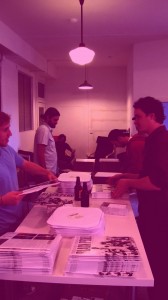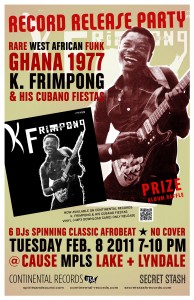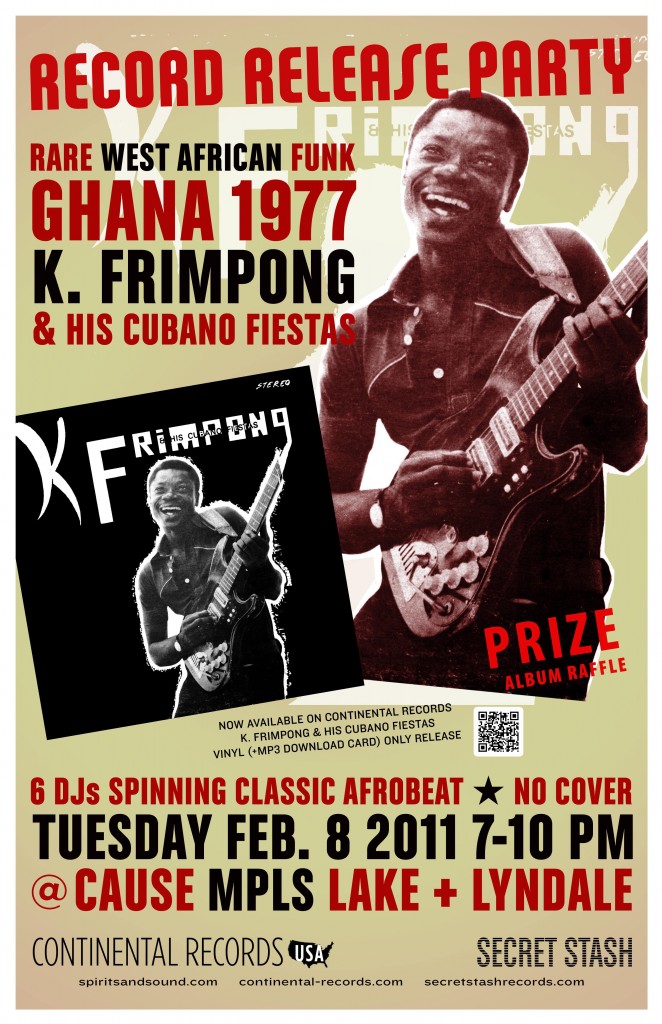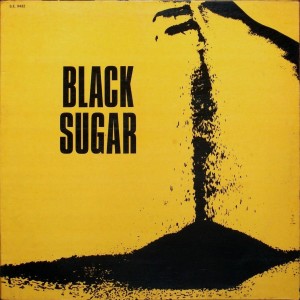Get a behind the scenes look at the remastering of Persian Funk with SSR’s own Cory Wong.
Persian Funk Coming 5.03.11
Watch the video for a sample of what is to come and to see some rare photos.
Win a free drink at the K Frimpong Party!
Be the first person to correctly answer the following question and you will win a free drink or shot at the K Frimpong & His Cubano Fiestas LP release party on Feb 8th at Cause Soundbar in Minneapolis. Your answer must be posted on our Facebook or Twitter page in order to win. If you’ve already won a drink at the party, you’ll have to sit this one out. Here is the question:
What was the name of the large music festival in Ghana that took place in ’71 and who were three of the artists that performed?
Good luck!
K Frimpong Release Party!
We’re so excited about the release of our first album under the Continental Records imprint, that we’ve decided to throw a little shindig. There will be 6 DJs spinning Afrobeat records all night long. We decided to keep this event in our neighborhood. It’ll be held at Cause Spirits & Soundbar, right around the corner from our headquarters in uptown/lynlake. If you are in the twin cities, please stop by and say hi. Here are the details:
What: K Frimpong & His Cubano Fiestas Release Party
Where: Cause Spirits & Soundbar (formerly known as “Sauce”)
3001 Lyndale Ave S, Minneapolis, MN 55408 (on the corner of Lyndale and Lake)
When: Tuesday, Feb. 8th 7pm-10pm
Cost: FREE!!!
There will be giveaways throughout the night
Mickey Murray Assembly Party
Mickey Murray Assembly Party
Jan 2012

The parts for the new Mickey Murray reissue are trickling into our offices. Everything will be here by the end of this week. That can only mean one thing…ASSEMBLY PARTY TIME! That’s right, it’s that time once again when we invite all our fellow vinyl addicts to the SSR offices to help assemble a new release. You may possibly be asking yourself, “what the hell are they talking about?” Let me explain…
We order all the different parts for our releases (jacket, vinyl, download card, etc) from different vendors. Rather than ship all the parts to the vinyl manufacturer and have them assemble it, we bring the assembly in house. This allows us a level of quality control that could never be achieved via 3rd party assembly. It’s also a great way to open our doors to the local community to come in and check out our operation from the inside.
Here is how it works. Come on by our offices in uptown and help assemble Mickey Murray records. There will be FREE local pizza and beer. There will also be a FREE copy of the limited edition version of the album (includes bonus 45) for those who help out. It’s a great way to meet other record enthusiasts in the Twin Cities. We’ve got a set of turn tables in the office, so feel free to bring a few records to share with the group. Check out the details below. We hope to see you there.
Where: Secret Stash Records World Headquarters
711 W Lake St
STE 211
Minneapolis, MN 55408
When: 6:30 PM ’till we’re done (usually take 2-3 hours)
Contact: 612-466-2224 or will@secretstashrecords.com
Black Sugar LP now avilable in web store
Those of you who have a copy of Peruvian Funk are already familiar with Black Sugar. This Peruvian funk/soul/rock outfit from Lima only recorded two LPs (71′ and 72′). This vinyl reissue of their debut LP was pressed by our friends at Lazarus Productions a few years ago. Original copies often sell for over $200 on ebay. When we licensed the Black Sugar tracks from them for Peruvian Funk we also bought their remaining inventory of this title. Now you can get your copy directly from us for only $13. We only have a few left (most were shipped to distributors overseas), so act fast if you would like one. When they’re gone, they’re gone.



